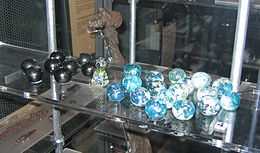Tafl games
 A reconstructed Hnefatafl gameboard | |
| Years active | 4th–12th centuries |
|---|---|
| Genre(s) |
Board game Abstract strategy game |
| Players | 2 |
| Setup time | < 1 minute |
| Playing time | Typically 5–20 minutes |
| Random chance | None |
| Skill(s) required | Strategy, tactics |
| Synonym(s) | Hnefatafl |
Tafl games are a family of ancient Germanic and Celtic strategy board games played on a checkered or latticed board with two armies of uneven numbers, representing variants of an early Scandinavian board game called tafl or hnefatafl in contemporary literature.
Although the size of the board and the number of pieces varied, all games involved a distinctive 2:1 ratio of pieces, with the lesser side having a king-piece that started in the centre. The king's objective was to escape to (variously) the board's periphery or corners, while the greater force's objective was to capture him. There is also some controversy over whether some tafl games (i.e. Hnefatafl and Tawlbwrdd) may have employed dice.[1] Tafl spread everywhere the Vikings traveled, including Iceland, Britain, Ireland, and Lapland.[2] Versions of Tafl, comprising Hnefatafl, Alea Evangelii, Tawlbwrdd (Wales), Brandubh, Ard Ri and Tablut, were played across much of Northern Europe from earlier than 400 AD until it was supplanted by chess in the 12th century.[3]
The term tafl (Old Norse: "table", "board"; pronounced [tavl])[4] is the original name of the game. However, Hnefatafl became the preferred term for the game in Scandinavia by the end of the Viking Age, to distinguish it from other board games, such as Skáktafl (chess), Kvatrutafl (Tables) and Halatafl (Fox games), as these became known.[3] The specific name Hnefatafl possibly arose as meaning "board game of the fist", from hnefi ("fist") + tafl,[5] where "fist" referred to the central king-piece. The precise etymology is disputed,[6] but hnefi certainly referred to the king-piece,[7] and several sources refer to Hnefatafl as "King's table". In Anglo-Saxon England, the term tæfl also referred to many board games. It is not known if the Anglo-Saxons had a specific name for the game or if they generically referred to it as "tæfl" in the way that modern people might refer to "cards".
Several games may be confused with tafl games, due to the inclusion of the word "tafl" in their names or other similarities. Halatafl is the Old Norse name for Fox and Geese, a game dating from at least the 14th century. It is still known and played in Europe. Kvatrutafl is the Old Norse name for Tables (the medieval forerunner of Backgammon). Skáktafl is the Old Norse name for Chess. Fidchell or Fithcheall (Modern Irish: Ficheall) was played in Ireland. The Welsh equivalent was Gwyddbwyll and the Breton equivalent Gwezboell; all terms mean "wood-sense".[8] This popular medieval game was played with equal forces on each side and thus was not a tafl variant, but rather may have been the medieval descendant of the Roman game Latrunculi or Ludus latrunculorum.[9]
Hnefatafl in Saga literature
.jpg)
Hnefatafl was mentioned in several of the medieval sagas, including Orkneyinga saga, Friðþjófs saga, Hervarar saga, and others. These three period treatments of Hnefatafl offer some important clues about the game, while numerous other incidental references to Hnefatafl or Tafl exist in saga literature.[10] In Orkeyinga saga, the notability of Hnefatafl is evident in the nine boasts of Jarl Rögnvald Kali Kolsson, who tops his list with skill at Tafl.[11] In Friðþjófs saga, a conversation over a game of Hnefatafl reveals that the king's men are red and the attackers white, and that the word hnefi does indeed refer to the kingpiece.[12] The most revealing – and yet most ambiguous – clues to Hnefatafl lie in a series of riddles posed by a character identified as Odin in disguise (see Gestumblindi) in Hervarar saga. One riddle, as stated in Hauksbók, refers to "the weaponless maids who fight around their lord, the [brown/red] ever sheltering and the [fair/white] ever attacking him," although there is controversy over whether the word weaponless refers to the maids or, as in other versions, to the king himself, which may support the argument that a "weaponless king" cannot take part in captures (see #Balance of play).[13] One may also note that the assignment of the colours of brown or red to the defenders and fair or white to the attackers is consistent with Friðþjófs saga. Another of Gestumblindi's riddles asks, "What is that beast all girded with iron, which kills the flocks? He has eight horns but no head, and runs as he pleases."[14] Here, it is the answer that is controversial, as the response has been variously translated as: "It is the húnn in hnefatafl. He has the name of a bear and runs when he is thrown;" or, "It is the húnn in hnefatafl. He has the name of a bear and escapes when he is attacked."[15] The first problem is in translating the word húnn, which may refer to a die (as suggested by the former translation), the "eight horns" referring to the eight corners of a six-sided die and "the flocks" that he kills referring to the stakes the players lose.[16] Alternatively, húnn may refer to the king, his "eight horns" referring to the eight defenders, which is more consistent with the latter translation, "He has the name of a bear and escapes when he is attacked."[17] Ultimately, the literary references prove inconclusive on the use of dice in Hnefatafl.
Tafl variants
-
 Hnefatafl
Hnefatafl -
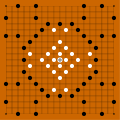 Alea Evangelii
Alea Evangelii -
 Tawlbwrdd
Tawlbwrdd -
 Brandubh
Brandubh -
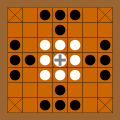 Ard Ri
Ard Ri -
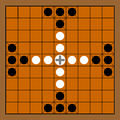 Tablut
Tablut
Hnefatafl
Hnefatafl was a popular game in medieval Scandinavia and was mentioned in several of the Norse Sagas. Some of these saga references have contributed to controversy over the possible use of dice in playing hnefatafl.[18] The rules of the game were never explicitly recorded,[19] and only playing pieces and fragmentary boards are extant, so it is not known for sure how the game was played. If dice were in fact used, nothing has been recorded about how they were employed. Archaeological and literary sources indicate Hnefatafl may have been played on a 13×13 or an 11×11 board.[20]
Alea evangelii
Alea evangelii, which means "game of the gospels",[21] was described, with a drawing, in the 12th-century Corpus Christi College, Oxford manuscript 122, from Anglo-Saxon England.[22] It was played on the intersections of a board of 18×18 cells. The manuscript describes the layout of the board as a religious allegory, but it is clear that this was a game based on Hnefatafl.
Tawlbwrdd
This variant was played in Wales. It is described as being played with 8 pieces on the king's side and 16 on the attacker's side. Robert ap Ifan documented it with a drawing in a manuscript dated 1587. His version was played on an 11×11 board with 12 pieces on the king's side and 24 on the opponent's side. His passage states:[23]
The above tawlbwrdd should be played with a king in the centre and twelve men in the places next to him, and twenty-four men seek to capture him. These are placed, six in the centre of each side of the board and in the six central positions. And two move the men in the game, and if one [piece] belonging to the king comes between the attackers, he is dead and is thrown out of the game, and the same if one of the attackers comes between two of the king’s men in the same manner. And if the king himself comes between two of the attackers, and if you say ‘Watch your king’ before he moves to that space, and he is unable to escape, you capture him. If the other says ‘I am your liegeman’ and goes between two, there is no harm. If the king can go along the [illegible] line, that side wins the game.
Brandub
Brandub (Modern Irish: Bran dubh) was the Irish form of tafl. We know from two poems[24] that it was played with five men against eight, and that one of the five was a "Branán", or chief. A number of 7×7 boards have been found, the most famous being the elaborate wooden board found at Ballinderry in 1932, featuring holes for pegged pieces, possibly to allow for portability of the game.[25] The name brandub means "black raven".[26]
Ard Ri
Ard Ri (Gaelic: High King) was a Scottish tafl variant played on a 7×7 board with a king and eight defenders against sixteen attackers. This is the least documented of the known tafl variants.[27]
Tablut
This variant from Sápmi, is the best documented version.[28] Carl Linnaeus recorded the rules and a drawing of the board in his journal during his 1732 expedition to Lapland. His description, in Latin, was incomplete, as he did not speak the Sami language of his hosts and described the game only from observing the players.[29] The game was played on a 9×9 mat of embroidered reindeer hide.[30] In his diary, Lachesis Lapponica, Linnaeus referred to the light (defending) pieces as "Swedes" and the dark (attacking) pieces as "Muscovites".[31] What may have been the same game was still being played in the late 19th century, as described in P.A. Lindholm's Hos Lappbönder (1884).[32]
Reconstruction
No complete, unambiguous description of the rules of a tafl game exists.[33] The best description we have from history is that given by Linnaeus of the game Tablut in the 1732 diary of his travels, Lachesis Lapponica.[34] The following rules are based on the 1811 translation of Lachesis Lapponica into English by James Edward Smith.[35]
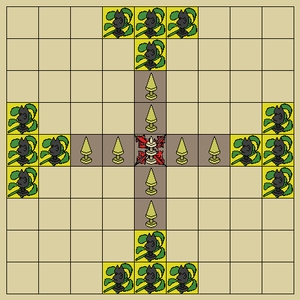
- The game is played on a 9×9 board. Initial setup is as shown in the diagram.
- The king starts on the central square or castle, called the konakis, which no other piece may ever occupy.
- The eight defenders, called Swedes, start on the eight squares adjoining the konakis, in the form of a cross.
- The sixteen attackers, called Muscovites, start in groups of four at the centre of each edge of the board. (In Linnaeus' notes, these squares were embroidered to signify them as the domain of the Muscovites.)
- All remaining squares (neutral zone) may be occupied by any piece during the game.
- Any piece may move any number of vacant spaces in any straight line [←↑→↓], but not diagonally. (Compare to the rook in Chess.)
- No piece may ever pass over another piece in its path.
- If the king should ever have an unimpeded path (through the neutral zone) to the edge of the board, unless he is immediately blocked by a Muscovite, he may escape and the game is over. (This rule suggests that the king may not escape through the domain of the Muscovites.)
- If the king should ever have a path of escape, he must call out "raichi"; if two paths of escape, then his escape is imminent and he must call out "tuichu". (Compare these to "check" and "checkmate" in Chess.)
- Any piece, save for the king, may be captured and removed from the board if it becomes surrounded on two opposite sides by enemies. (This is known as custodial capture.)
- If the king is surrounded on all four sides by enemies, he is taken prisoner. If he is surrounded on three sides, he may escape by the fourth.
- If the king is on a square adjoining the konakis and is surrounded on three sides by his enemies and the fourth by the konakis, he is captured. (This rule suggests that once the king has left the konakis, he can never return.)
- If the king is captured, the Swedes are conquered and the Muscovites victorious.
Several problems of gameplay are left woefully ambiguous or completely untouched in Linnaeus' notes, and some translations are problematic.[36] There are also several other variations played by modern reconstructionists. More detailed information on reconstructing the rules of play can be found in this article by Sten Helmfrid.
Balance of play
There is some controversy concerning the widely reported imbalance of the game, as the rules strongly favor the king,[37] although there are several rule modifications that can produce more balanced play, such as a weaponless king (the king cannot participate in captures), escape to the corners (rather than to the edges), or hostile attacker camps (the king and defenders may be captured against a vacant attacker camp square).[38] Schmittberger (1992) even reveals some workarounds to produce more balanced play without modifying the rules of gameplay.
One such solution is by bidding: Players take turns bidding on how many moves it will take them to win the game. The lowest bidder gets the king. Thus, one player may open with a bid of 15 turns, the other player may counter with a bid of 14 turns, and the first player, more confident in his ability to escape in 13 rounds than in his ability to contain for 14, may bid 13 and take the king's side. If that player does not escape within 13 turns, the other player wins.[39] Another workaround is to play a two-round match, in which players switch sides after the first round. If the king escapes both rounds, the winner is the player whose king escaped in the fewest turns.[40]
The description of Tawlbrydd by Robert ap Ifan (preceding Linnaeus' account by 145 years) states that the king could be captured by two men. Peterson suggests that Linnaeus' special capture of the king is incorrect, and states that statistics from modern games played with four-man capture of the king show that white wins more often than black.[41] However, it has not yet been demonstrated that balanced play results from rules allowing for a two-man capture of the king. Interestingly, some sources indicate that Scandinavian museum reconstructions of Hnefatafl typically stipulate that the king may be captured by only two attackers unless he is still in his hall, in which case he must be surrounded on all four sides.[42]
Legacy
Around 1960, Milton Bradley published Swords and Shields, which was essentially Tablut as recorded by Linnaeus, but with the Swedes transformed into shields (with a king shield) and the Muscovites transformed into swords. Tafl seems also to have been the basis for two other modern board games that each bear significant resemblance to the historical games, but with some important differences. Both games feature similar symmetry but diverge from the classic 2:1 attacker/defender ratio, and both have important differences in their tactics. Breakthru was developed in the 1960s as part of the 3M bookshelf game series. It features tafl-like symmetry,[43] but with twelve defenders plus one "flagship" (cf. king) pitted against twenty attackers upon a tiered board, so that the objective of the defenders is to escort the flagship from the centre to the outer zone of the board.[44] Apart from the distinction of the inner zone and outer zone, there are no distinctive spaces on the Breakthru board. Breakthru also features a distinctive double move, whereas no evidence points to such a move in any of the historical games. Thud, a modern game inspired by a series of fantasy novels by Terry Pratchett (which in turn were inspired by the historical tafl games), also features the general symmetry of tafl games, although it is played on an octagonal board with only eight defenders pitted against thirty-two attackers. Thud also features a "Thudstone" (cf. konakis), but no kingpiece. There are also important differences in the moves and attacks in Thud.
In 2008, Hnefatafl was revived by Peter Kelly in the island of Fetlar in Shetland, where the annual World Quickplay Hnefatafl Championships are now held each summer under the auspices of the Fetlar Hnefatafl Panel. The 2008 Champion was Wendy Sutherland from Yorkshire, while the 2009 and 2010 Championships were won by Tim Millar from Somerset. The term "quickplay" refers to the time limit of ten seconds per move, marked by the sounding of a gong.[45]
See also
- Alea evangelii—an Anglo-Saxon variant documented in a medieval manuscript
- Breakthru—a modern game inspired by Tafl games
- Fidchell—an ancient Irish board game
- Fox games—e.g. Fox and geese
- Game of the Gods—a Norse literary motif
- Tables—an unrelated board game with a similar name
- Thud—a modern game inspired by Tafl games
References
Notes
- ↑ Helmfrid 2005, pp. 10–11, discusses a set of intriguing yet ultimately puzzling riddles related in Hervarar Saga, referring to hnefatafl. Bayless 2005, pp. 15–16, suggests that several archaeological finds in Scandinavia reveal hnefatafl sets that included dice, and discusses controversy over whether the very name tawlbwrdd suggests the throwing of dice.
- ↑ Murray 1951, p. 56, Helmfrid 2005, p. 2
- ↑ 3.0 3.1 Murray 1951, pp. 56–57
- ↑ Ellis 1869, pp. 554, 559. The mutation of f to [v] is included in the table on p. 554 (also here attributed to Jakob Grimm), and borne out in the comparative translation on p. 559
- ↑ Helmfrid 2005, p. 1, discusses this etymology, elements of which are confirmed by Zoëga 1910, "hnefa"/"-tafl"/"hnefi".
- ↑ Murray 1951, p. 60, says "hnefi (meaning doubtful, but used of the king-piece)", while Helmfrid 2005, p. 1, notes that hnefa is the genitive form of Icelandic hnefi (fist), but concedes "it is often translated as king."
- ↑ Murray 1951, p. 60. Helmfrid, Bell, and Hervarar Saga all agree on this point.
- ↑ Bayless 2005, p. 17
- ↑ Helmfrid 2005, p. 7, and Murray 1951, p. 35. Also, Bayless 2005, p. 17, further discusses the link between Fidchell and Latrunculi and the difference between these games and the tafl family.
- ↑ Helmfrid 2005, p. 11
- ↑ Peterson 2005, Helmfrid 2005, p. 11. Original source: Rǫgnvaldr jarl kali Kolsson 1158, Orknøsk jarl og skjald Original text (Icelandic). An English translation is prominent in the Viking Answer Lady's King's Table article.
- ↑ Helmfrid 2005, p. 10
- ↑ Helmfrid 2005, p. 10, reproduces the above quotation from Hauksbok and discusses the "weaponless" controversy.
- ↑ Quoted in Helmfrid 2005, p. 10. An alternative translation is here on the web.
- ↑ Both translations offered in Helmfrid 2005, pp. 10–11
- ↑ Helmfrid 2005, p. 11. This is a close paraphrasing of Helmfrid's own words.
- ↑ Helmfrid 2005, p. 11. The idea that the húnn is the king is supported by Murray (p. 61).
- ↑ Helmfrid 2005, pp. 10–11, discusses the riddles in Hervarar Saga, which have been interpreted to suggest the use of dice in Hnefatafl.
- ↑ Bell 1979, p. 77
- ↑ Bayless 2005, p. 15, mentions an 11×11 Hnefatafl board from the 12th century, found near Trondheim, and Helmfrid 2005, p. 7, reports that Robert ap Ifan drew an 11×11 board in his manuscript, while Murray 1951, p. 58, reports that the board found on the Gokstad ship had 13×13 squares on one side and Nine men's morris on the reverse.
- ↑ Helmfrid 2005, p. 9
- ↑ Murray 1951, p. 61
- ↑ Ifan 1587, p. 4, cited in Murray 1951, p. 63
- ↑ Helmfrid 2005, pp. 7–8. In Bayless 2005, p. 17, these passages are reproduced and well referenced.
- ↑ Murray 1951, p. 59, discusses the Ballinderry board with an accompanying sketch of the board. This board is also discussed by Helmfrid 2005, p. 12, and Bayless 2005, p. 14, calls it "the most celebrated find" in Ireland.
- ↑ Bayless 2005, p. 17, Helmfrid 2005, p. 7
- ↑ While there is a dearth of information in the published sources, Ard Ri is briefly described and illustrated in four web articles: , , , .
- ↑ Helmfrid 2005, p. 2
- ↑ Helmfrid 2005, p. 3
- ↑ Bell 1979, p. 78
- ↑ Smith 1811, p. 56
- ↑ According to Helmfrid, Lindholm (1884)states, "If there are not cards enough for everyone, it may happen that a few men sit down and play a sort of chess, where the pieces are called Russians and Swedes, and try to defeat each other. Here intense battles are fought, which easily can be observed on the players, who sometimes are so absorbed that they cannot see or hear anything else." Qtd in Helmfrid 2005, p. 5
- ↑ Murray 1951, p. 61, states that of the many references to Tafl in the sagas, the only clue about the game is given in Friðþjófs saga, although this too is ambiguous and has been construed as a reference to Chess.
- ↑ Bell 1979, p. 77. Bell also provides his own redrawing of Linnaeus' sketch of the Tablut board (confer with the drawing rendered in Smith, p. 55).
- ↑ Smith 1811, pp. 55–58
- ↑ Helmfrid 2005, p. 4
- ↑ Schmittberger 1992, p. 24
- ↑ Each of these rule variations are found in modern tafl variants, as can be found in #External links. Also, all of these rules are available parameters in this applet. These rule variations were also discussed by Helmfrid.
- ↑ Schmittberger 1992, p. 25
- ↑ Schmittberger 1992, p. 28
- ↑ Peterson 2005. This imbalance is also a subject of Schmittberger 1992, pp. 24–25
- ↑ Helmfrid 2005, pp. 14–15, and Aage Nielsen both comment on this peculiarity.
- ↑ Breakthru at BoardGameGeek
- ↑ "How to Play Breakthru" 1965 Minnesota Mining and Manufacturing Company.
- ↑ "Somerset glass sculptor retains Viking chess game world title". Shetland Times. 2010-08-02. Retrieved 2013-05-29.
Bibliography
- Bayless, M. (2005). "Alea, Tæfl, and Related Games: Vocabulary and Context," in Latin Learning and English Lore, ed. Katherine O’Brien O’Keeffe and Andy Orchard, 2 vols., vol. II, pp. 9–27. Toronto: University of Toronto Press. ISBN 0-8020-8919-4. Search inside this book.
- Bell, R. C. (1979). Board and Table Games from Many Civilizations (Revised ed.). New York: Dover Publications, Inc. ISBN 0-486-23855-5. LCCN 79-51819
- Ellis, A. J. (1869). On Early English Pronunciation. Part II: On the Pronunciation of the XIIIth and Previous Centuries, of AngloSaxon, Icelandic, Old Norse, and Gothic, With Chronological Tables of the Value of Letters and Expressions of Sound in English Writing. London: Philological Society – Asher & Co. ISBN 1-4021-9646-6. OCLC 3951183
- Helmfrid, S. (2005). "Hnefatafl: The Strategic Board Game of the Vikings". 23 April 2005. Accessed 20 December 2007.
- "How to Play Breakthru". Breakthru: Strategic Game of Evasion or Capture (1965). 3M Bookshelf Games. Minnesota Mining and Manufacturing Company.
- Ifan, Robert ap (1587). Welsh National Library, MS 158. Cited in Murray 1951, p. 63
- Murray, H. J. R. (1951). A History of Board-Games Other than Chess. Oxford: Oxford University Press. ISBN 0-19-827401-7. LCCN 52-3975 OCLC 1350513
- Peterson, N. (2005). Hnefatafl: An Experimental Reconstruction.
- Schmittberger, R. (1992). New Rules for Classic Games. John Wiley & Sons. ISBN 0-471-53621-0. LCCN 91-22386
- Smith, J. E. & Linné, C. (1811). Lachesis Lapponica. London: White and Cochrane. LCCN 05-8960 OCLC 2456941 Digitized copy on the web
- Zoëga, G. T. (1910). A Concise Dictionary of Old Icelandic. Oxford: Clarendon Press. LCCN 46-29683 OCLC 3471226
External links
| Wikimedia Commons has media related to Tafl. |
- Play Online Play variations of Tablut online at Boardspace.net
- Play games online on Jocly.com, including tablut, ard ri, hnefatafl, tawlbwrdd, brandubh, alea evangelii and other games
- Hnefatafl: The Strategic Board Game of the Vikings a scholarly article by Sten Helmfrid
- King's Table an illustrated article on tafl games by the Viking Answer Lady
- Norse Games an article covering primarily archaeological evidence
- Hnefatafl: the Game of the Vikings Java applet allows online play of numerous variations featuring user-selected rules
- Hnefatafl a multilingual explanation, and Java applets to play 9×9 or 11×11 variants online
- igGameCenter play Hnefatafl online via browser or iGoogle gadget
- Direct download of free Hnefatafl print and play set in A4 and letter formats
- Hnefatafl at BoardGameGeek
- Tafl games on the Open Directory Project
| ||||||||||||||||||||||||||||||||
| |||||||||||||||||||||||||||||||
